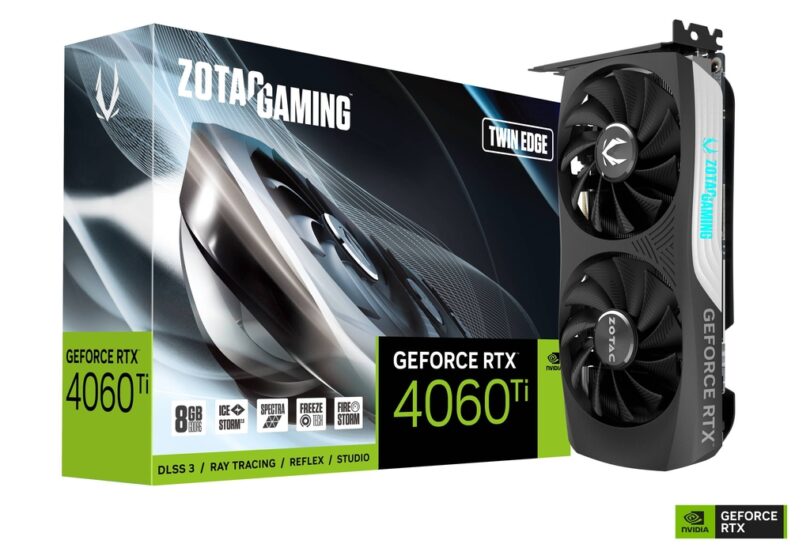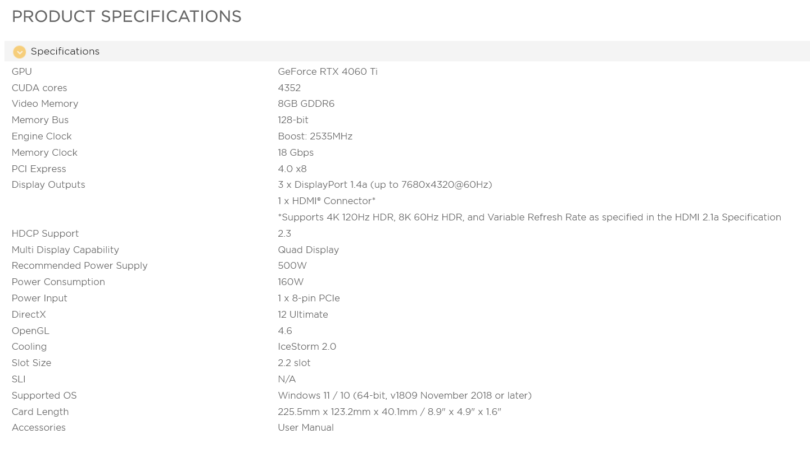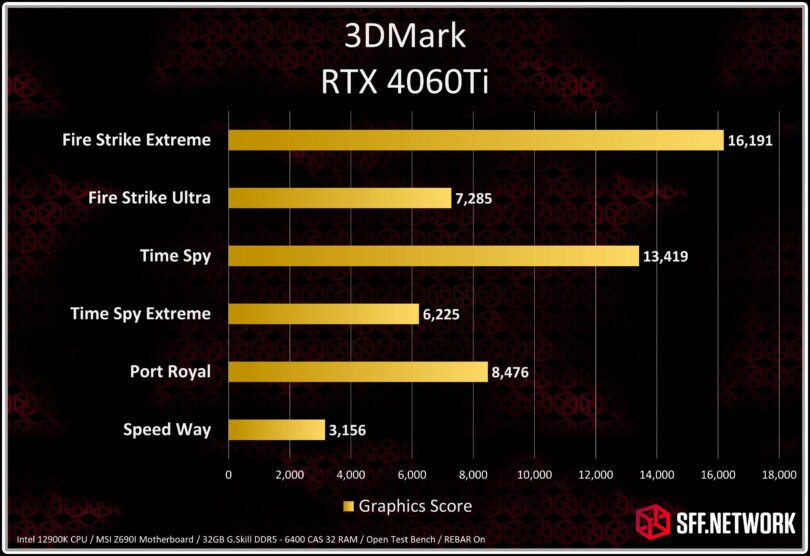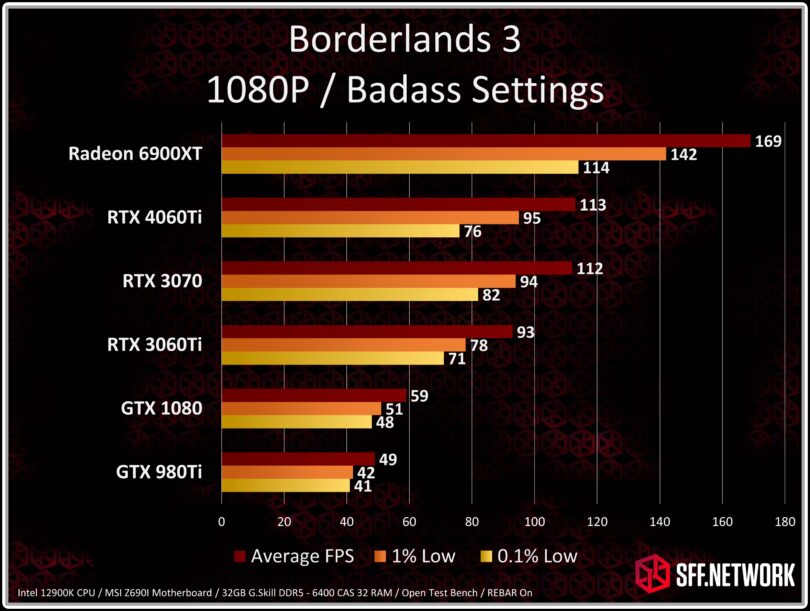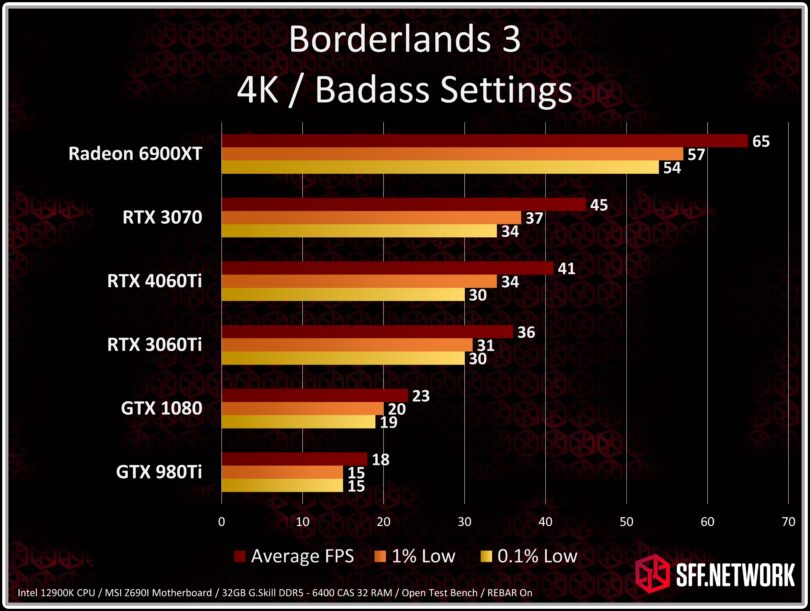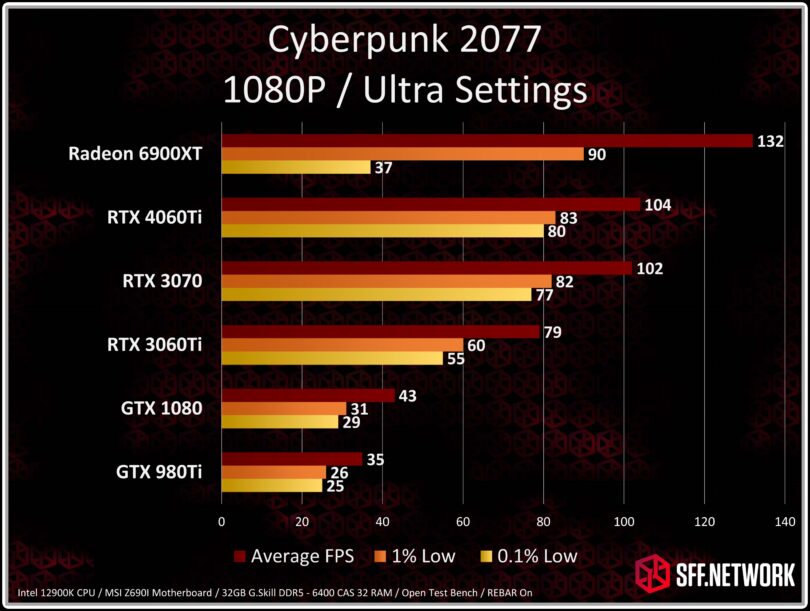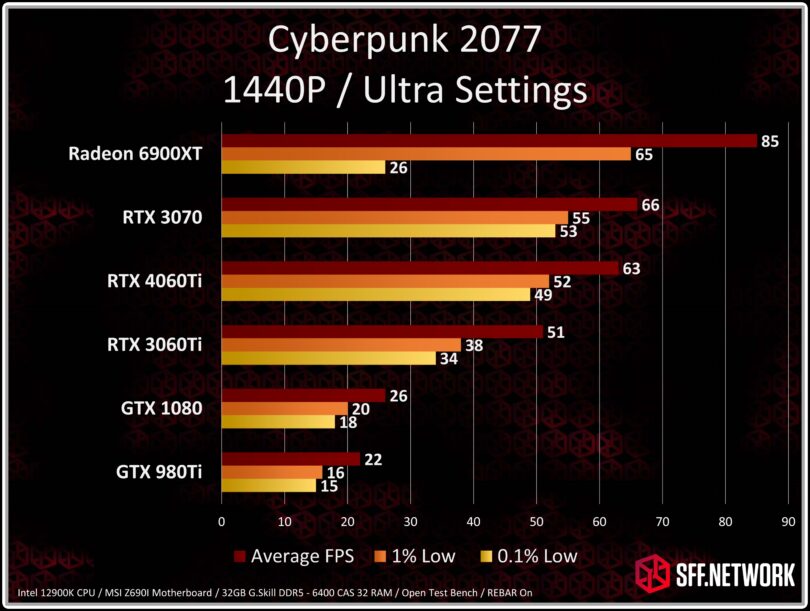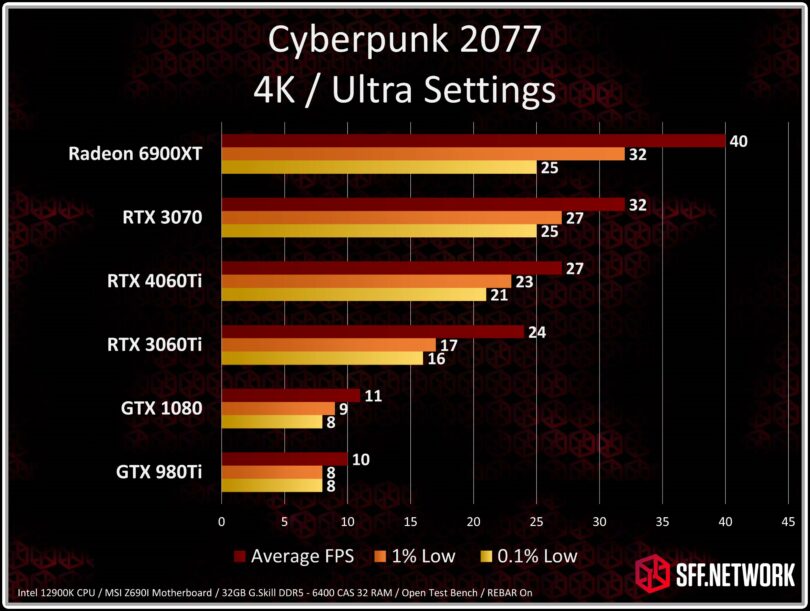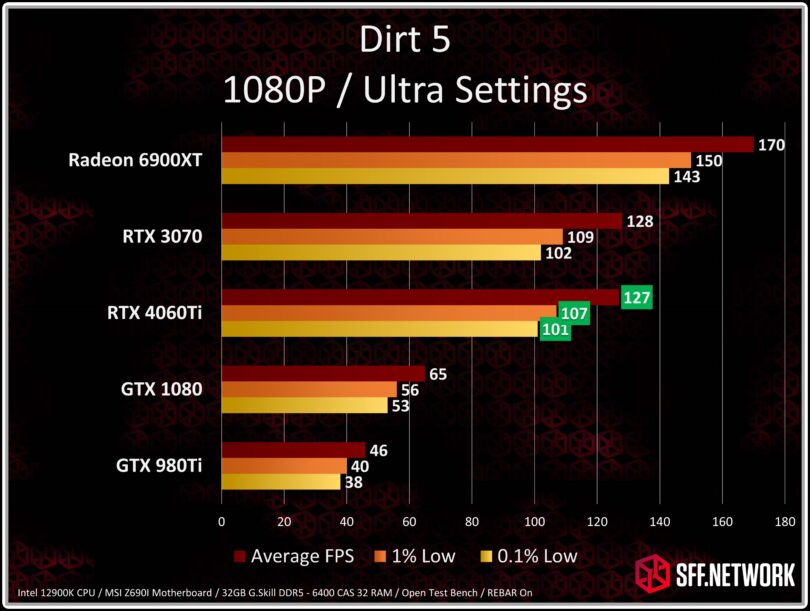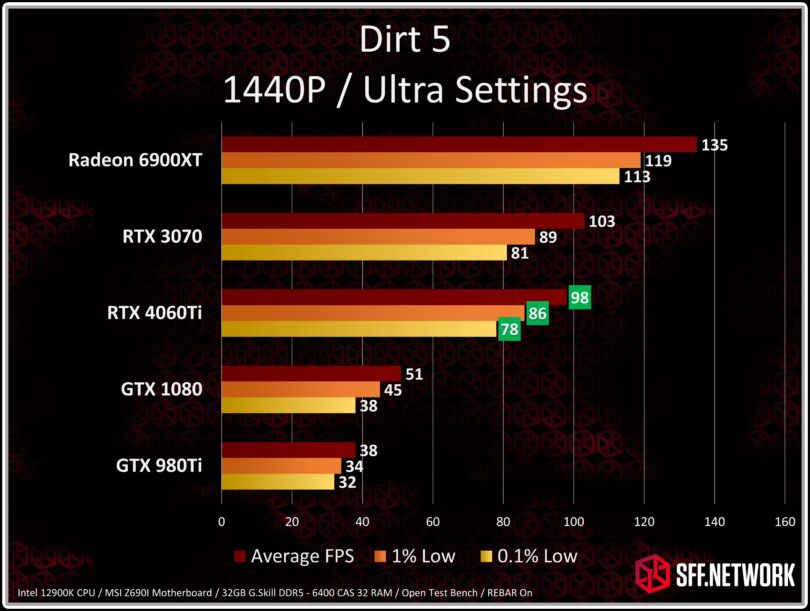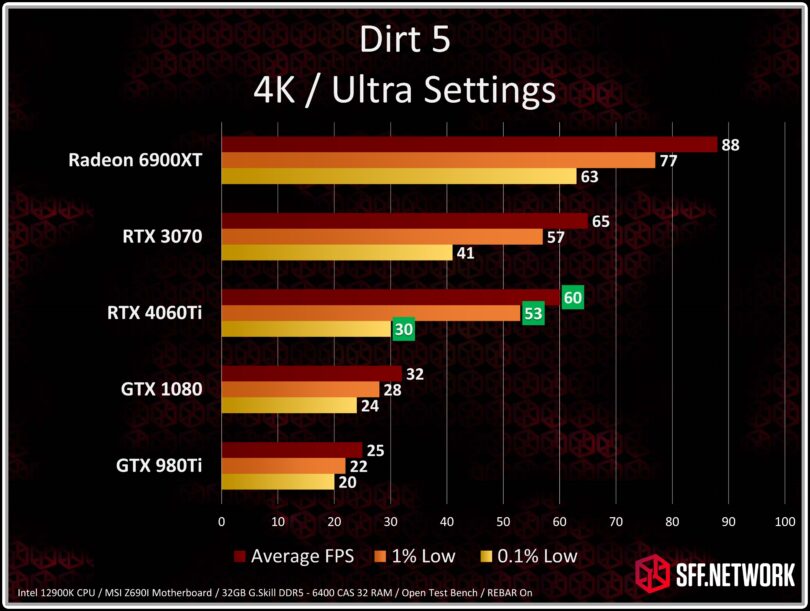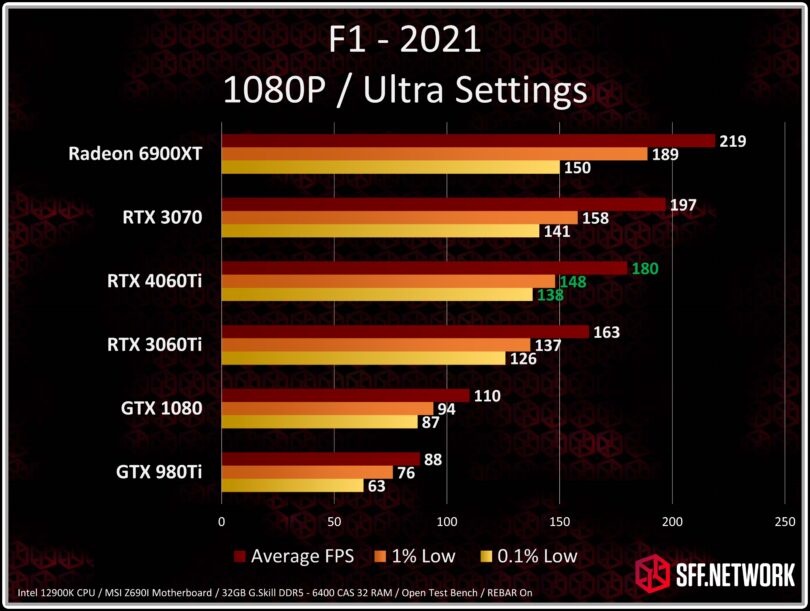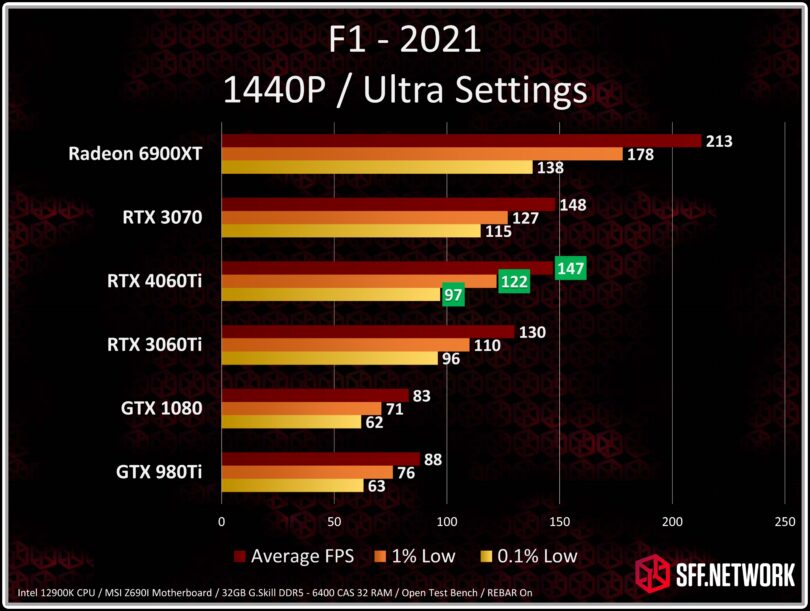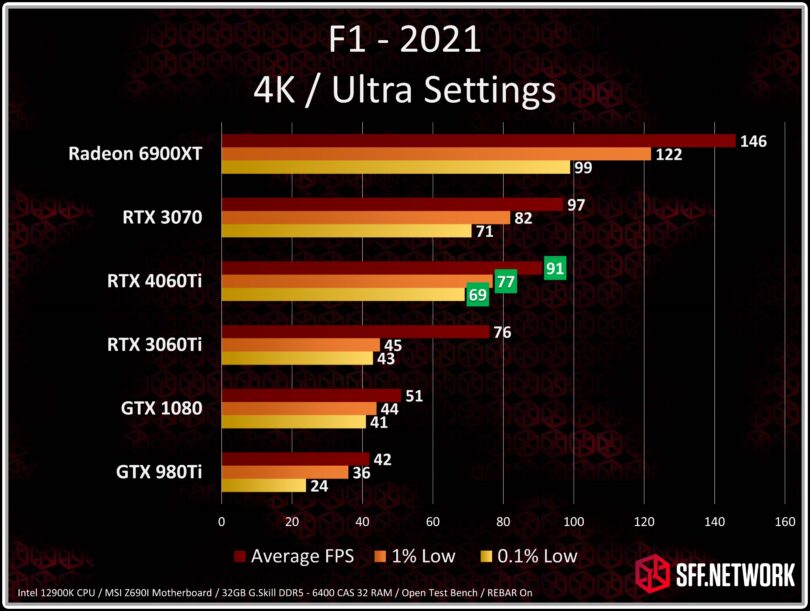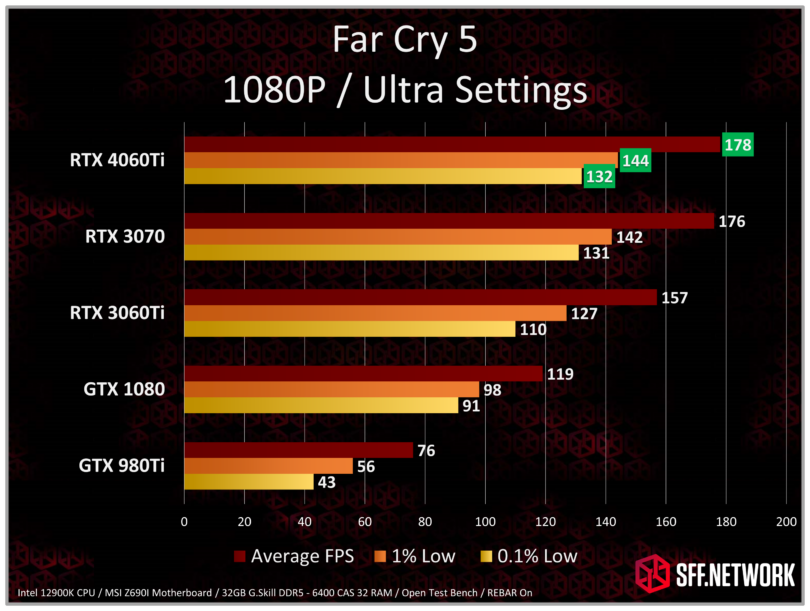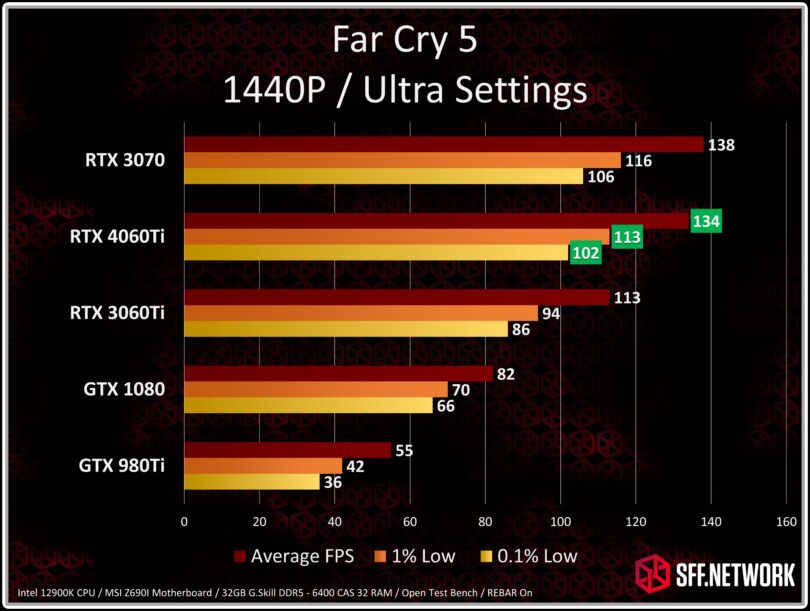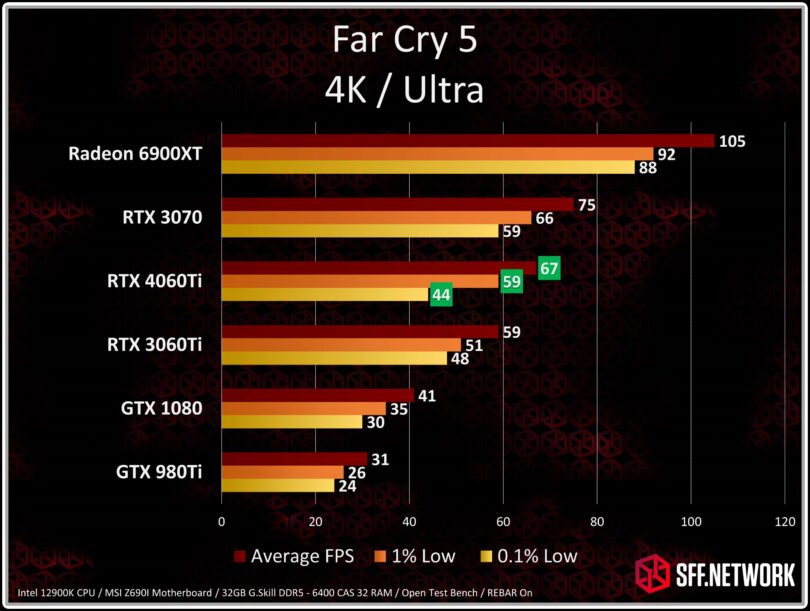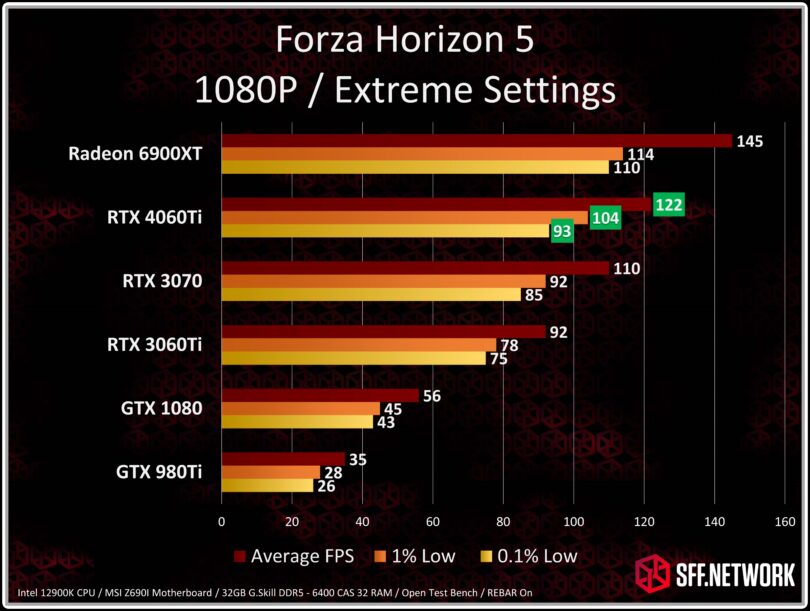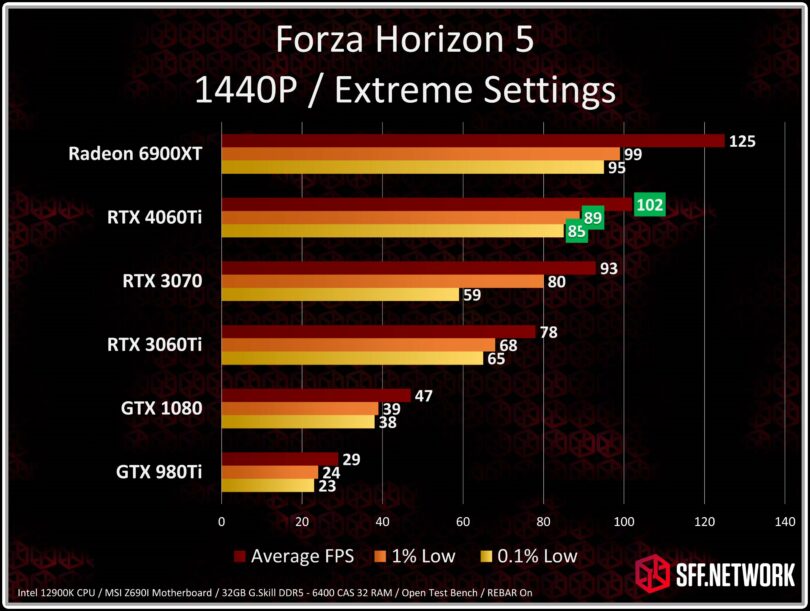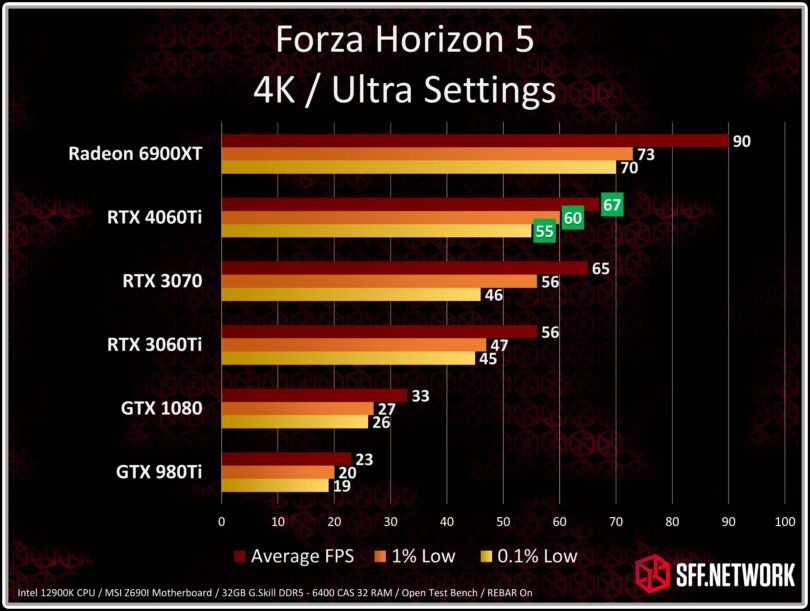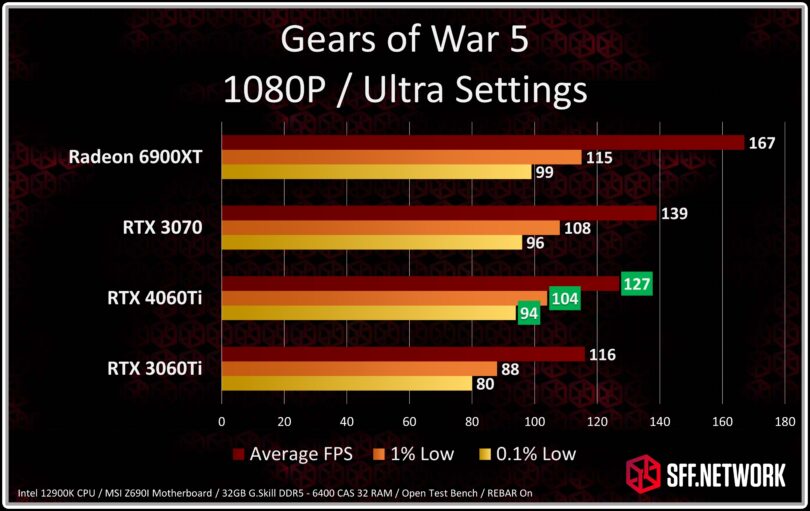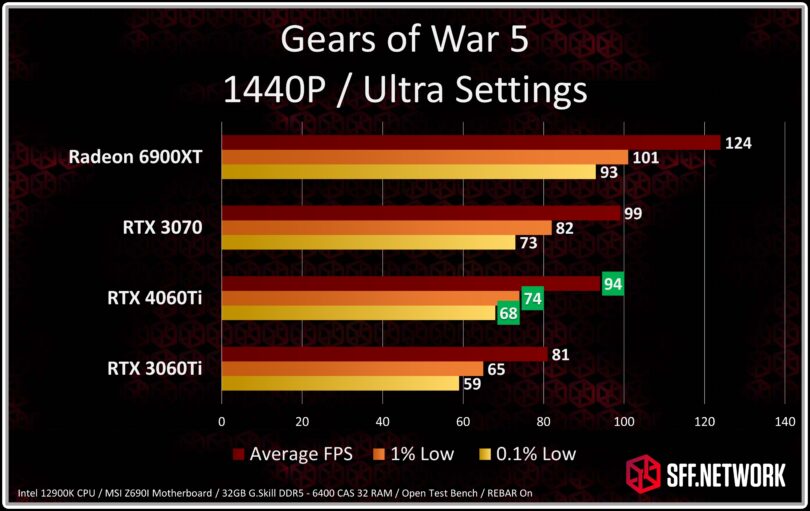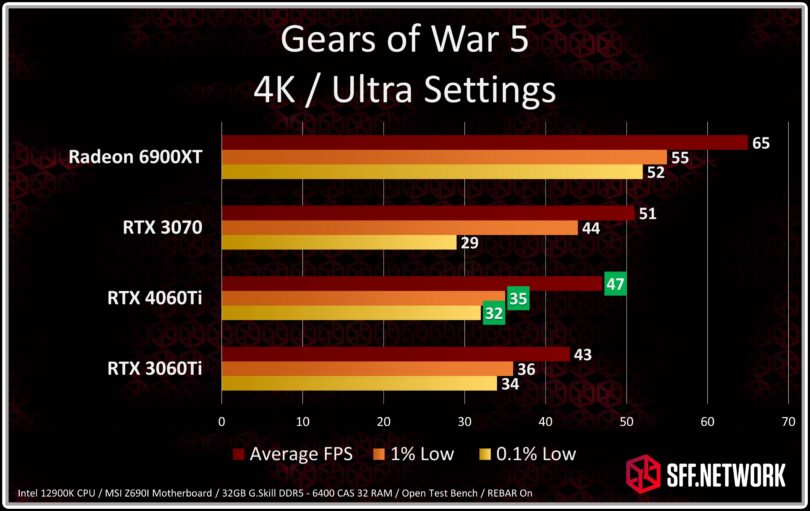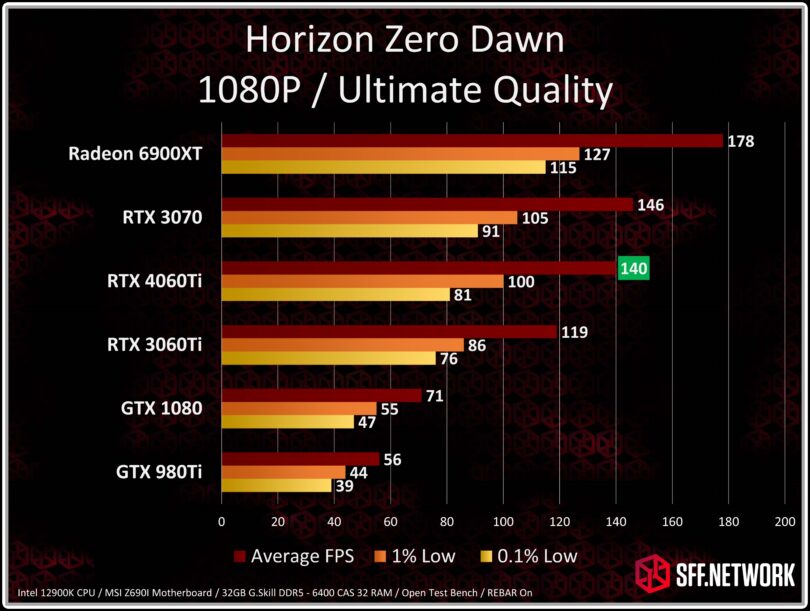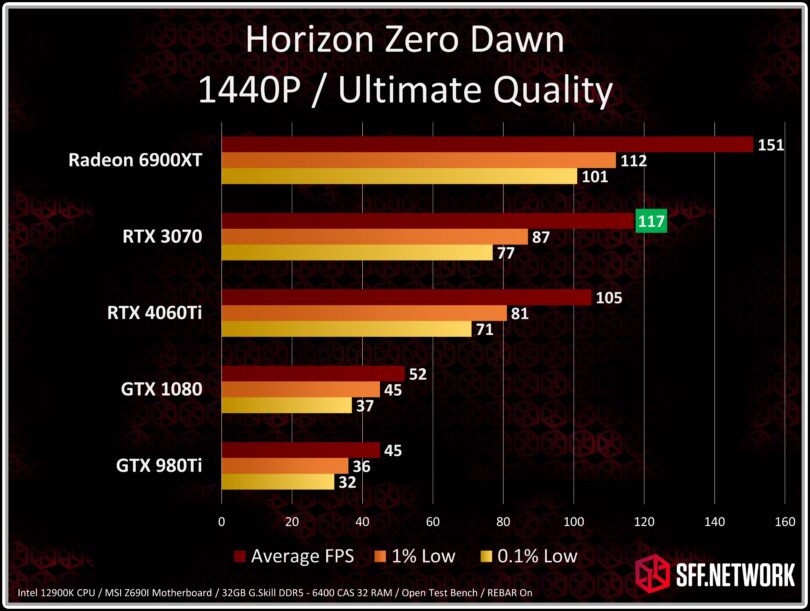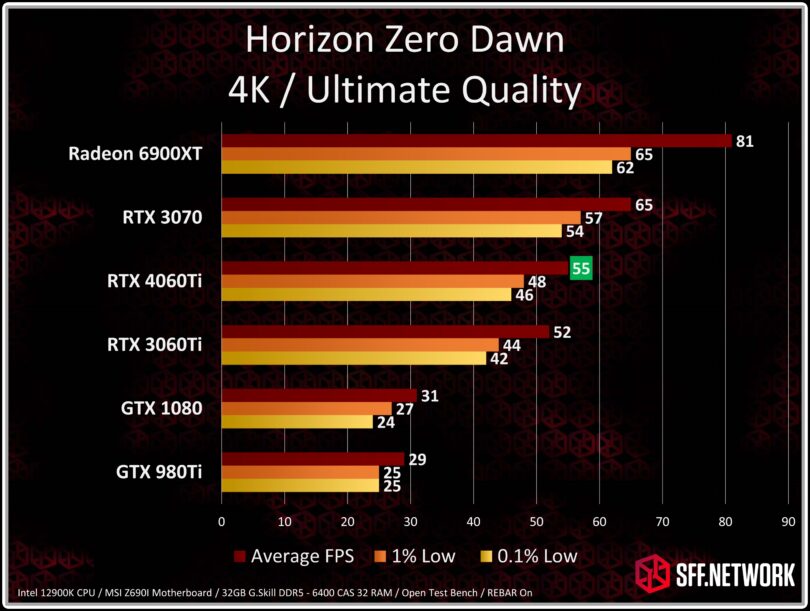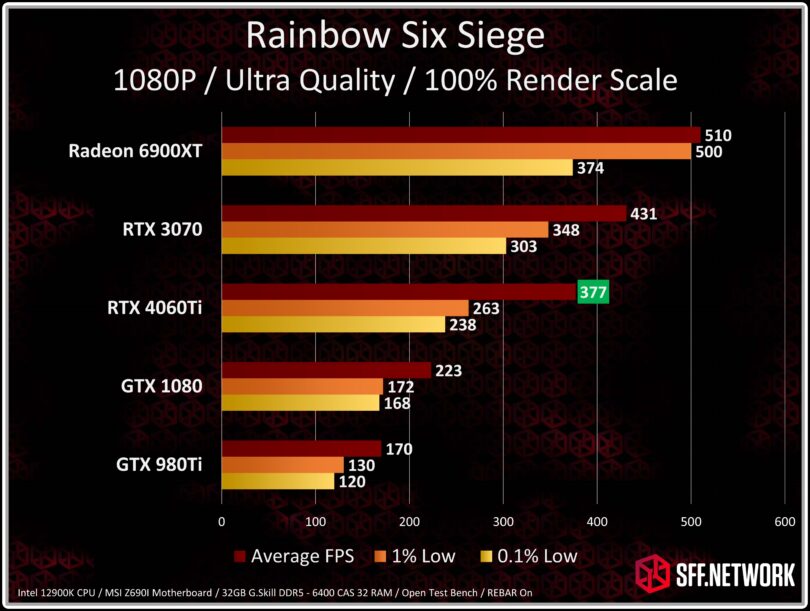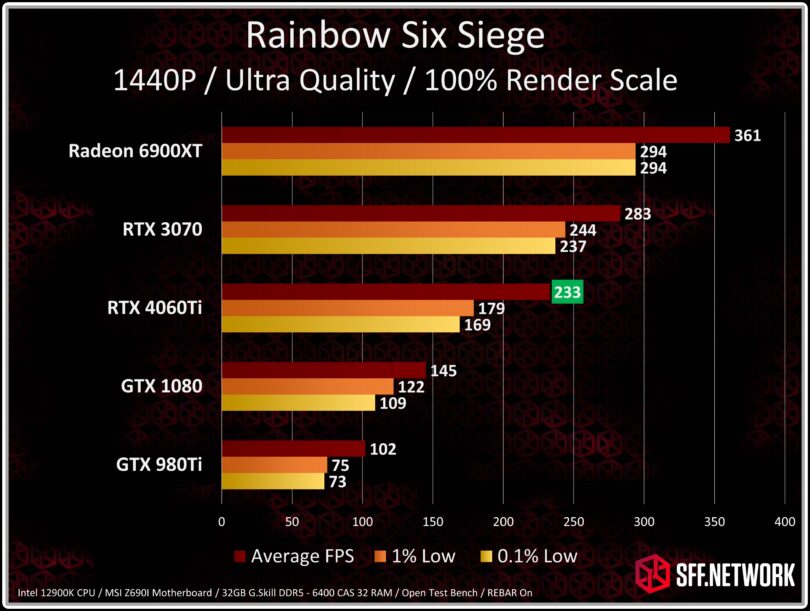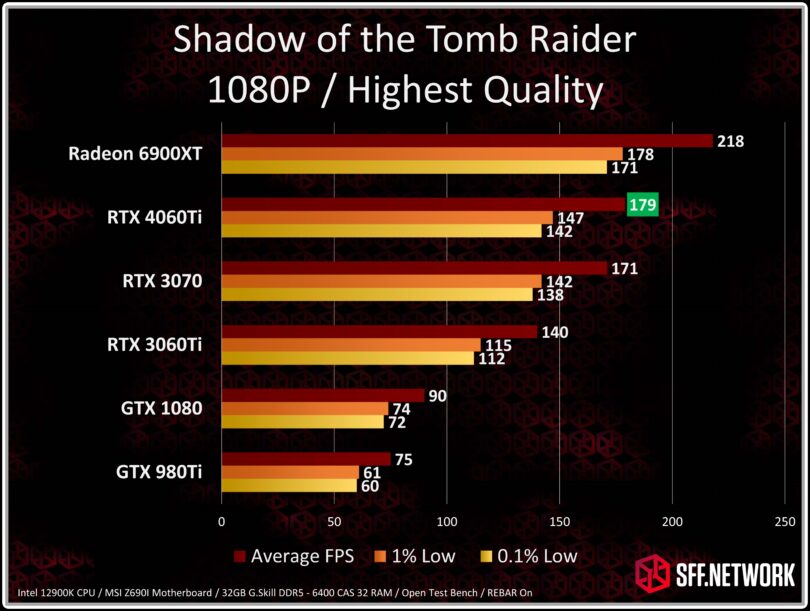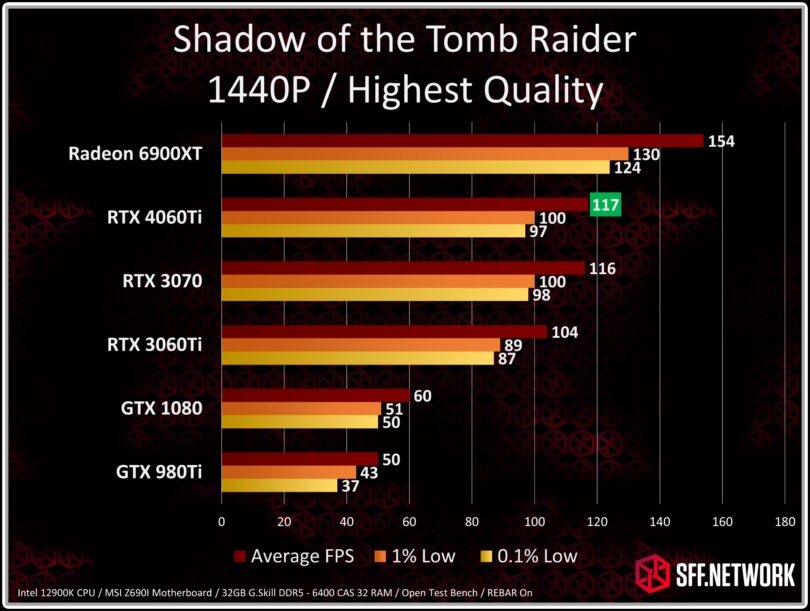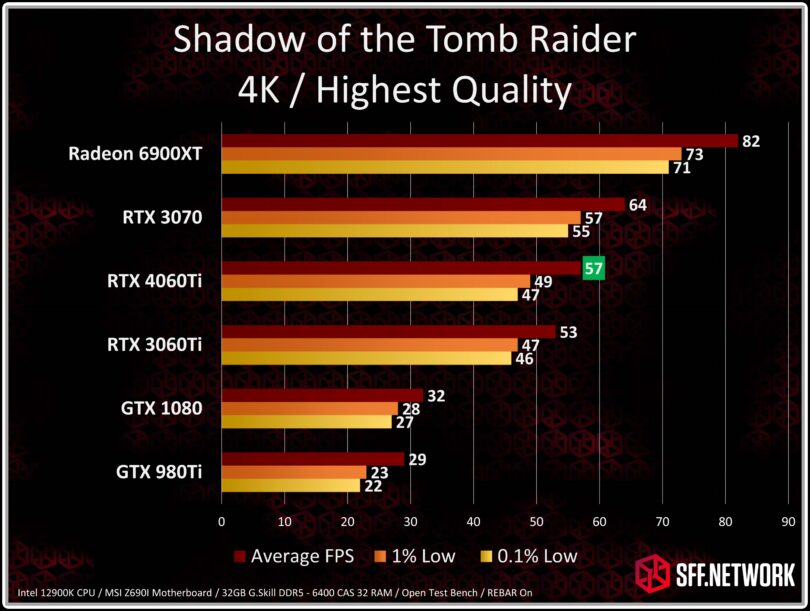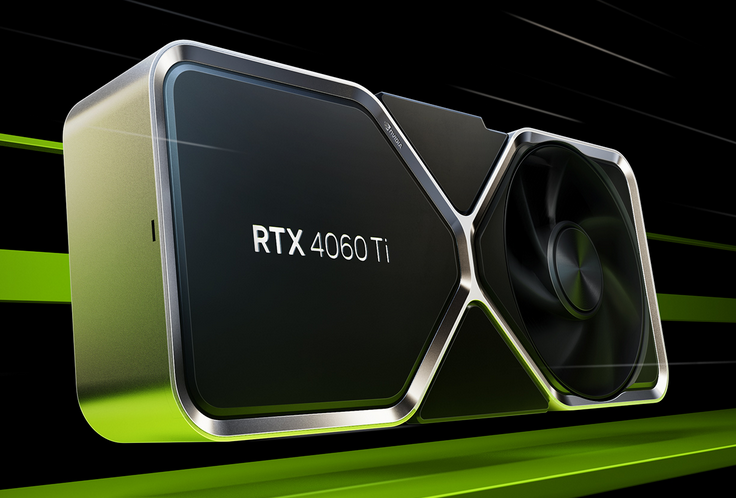
I’m not going to waste time with a long and fluffy opening. Nvidia has launched the RTX 4060Ti and it has not gone well. By now, most people know the RTX 4060Ti has been a let down in terms of performance for the price. Let’s start off by looking at why.
Why are Gamers Upset?
“The Dwarves delved too greedily and too deep. You know what they awoke in the darkness…shadow and flame” – Lord of the Rings.
The raw performance has been disappointing. The bus bandwidth and memory size has been disheartening. The price to performance has been a sticker shock. Why? Very simply it doesn’t offer as much as older cards used to. Let’s look at the old launches for reference.
At $379, the 8GB GTX 1070 could match the performance of the $649 6GB GTX 980TI
At $350 the 6GB RTX 2060 could match the performance of the $599 8GB GTX 1080.
At $399 the 8GB RTX 3060TI could match the performance of the $699 8GB RTX 2080 Super.
At $399 the 8GB RTX 4060Ti sort of matches the performance of the $499 8GB RTX 3070 but sometimes isn’t any faster than the $399 8GB RTX 3060Ti.
Adjusting for inflation, the GTX 1070 would cost $465 (in 2023 dollars), but the GTX 980Ti would have cost $850 (in 2023 dollars).
However, it’s not just the price.
The 8GB RTX 1070 was launched nearly seven years ago in 2016. It’s been a long lived card. VRAM of mid-range Nvidia cards hasn’t increased at all since then for the same money. That was fine when developers were aiming at the 8GB total memory of the PS4 and Xbox One. That time has passed, and for the last three years, developers have been upping their expectations to the PS5 and Xbox Series X which both have 16GB of total memory to work with. While the consoles do split their memory between work ram and video memory, games using well over 8GB of video memory are quickly becoming the norm. In fact, in the last year, 8GB GPUs have been suffering crippling performance issues with the newest games on PC. Developers have had to release post-launch patches to address this issue time and time again, with mixed results.
Let’s put this another way and look at historic increases in VRAM.
In 2002 Nvidia launched the GeForce 4 Ti 4600 for $399 or roughly $670 adjusting for inflation to 2023. It was the fastest card for its time and featured 128MB of VRAM. That was quite a bit back then as consoles of the day had at most 64MB of combined memory. Fast forward seven years to 2009, and you have Nvidia launching the GTX 285 for $359 (roughly $428 in 2002 dollars adjusting for inflation to 2009). The GTX 285 came with 1024MB of VRAM on a 512bit interface. In those seven years, the GPU cost went down by 10% (approximately 16% accounting for inflation from 2002 to 2010), VRAM increased by 8 times, and the feature set was vastly different.
Let’s look at second example.
In 2011 Nvidia launched the GeForce GTX 570 with 1.25GB of VRAM for $349 or roughly $480 accounting for inflation in 2023. Seven years later in 2018, the RTX 2060 arrived with 6GB of VRAM for $350 or about $390 in 2011 dollars adjusting for inflation from 2011 to 2018. During those 7 years there was a 4.8X increase in VRAM while costs stayed the same or went down by about 10% factoring inflation.
Now let’s look at the RTX 4060Ti.
The 4060Ti launches at the same price as the 3060Ti at $399. To be fair, accounting for insane and historically bad inflation between these card launches, it actually should cost about $450 . However, the RTX 4060Ti offers no additional VRAM, very little additional raw performance, and features that are only of value to either video editors, streamers, or people playing games that don’t require split second accuracy. It uses a chip historically seen in the lower range or entry level products, and it already struggles with modern game VRAM usage.
Wait! You compared the VRAM over a seven year time period! You AMD shill! Let’s see generation over generation!
Ok…we will.
1997 – Nvidia Riva 128 – 4MB
1998 – Nvidia Riva TNT – 16MB
1999 – Nvidia Riva TNT2 – 32MB
1999 – Nvidia GeForce 256 – 32MB
2000 – Nvidia GeForce2 – 64MB
2001 – Nvidia GeForce 3 – 128MB
2002 – Nvidia GeForce4 – 128MB
2003 – Nvidia GeForce FX – 256MB
NOTE: From this point forward I’ll be looking at cards in the $350 to $450 price range as prices began to rise substantially.
2004 – Nvidia GeForce 6000 Series – 256MB ($400)
2005 – Nvidia GeForce 7800GT – 256 MB ($449)
2006 – Nvidia GeForce 8800GTS – 320MB ($449)
2008 – Nvidia GeForce 9800 GTX – 512MB ($229) (GeForce 9000 Series has a weird pricing structure.)
2009 – We don’t speak of the GeForce 100 series.
2009 – Nvidia GeForce GTX 285 – 1024MB ($359)
2010 – The GeForce 300 series live only in a shadow realm of OEM builds. Myth says if you stand in front of a mirror and call their name three times, Jensen will appear and present you with an autographed spatula.
2010 – Nvidia GeForce GTX 470 – 1280MB ($359)
From this point forward I will also include performance equivalent from the previous generation.
2010 – Nvida GeForce GTX 570 – 1280MB ($359) – Performance equivalent of GTX 480.
2012 – Nvidia GeForce GTX 670 – 2048MB ($399) – Performance equivalent far exceeding GTX 580.
2013 – Nvida GeForce GTX 770 – 2048MB ($399) – Performance equivalent of GTX 680.
2014 – Legend tells the tail of rogue wandering gamers known as the GeForce 800 series. Found only in laptops, these mysterious GPUs were from three different architectures, and vanished almost as quickly as they appeared.
2014 – Nvidia GeForce GTX 970 – 4GB-ish ($329) – Performance equivalent of nearly GTX 780Ti.
2016 – Nvidia GeForce GTX 1070 – 8GB ($380) – Performance equivalent of 980Ti.
2019 – Nvidia GeForce RTX 2060 – 6GB ($350) NOTE: Reduction of VRAM by 2GB. Performance equivalent of just below a GTX 1080 and a bit above a 1070Ti.
2021 – Nvidia GeForce RTX 3060Ti – 8GB ($399). – Performance equivalent of RTX 2080.
2023 -Nvidia GeForce RTX 4060Ti – 8GB ($399 or $499 for 16GB model). Performance equivalent of a bit above a RTX 3060Ti and sometimes as much as a RTX 3070.
Since 2016, the $350 to $450 range of Nvidia GPUs VRAM size has either been stagnant or moving backward. Now the $400 card market is substantially loosing performance equivalency by going from previous 80 series cards to less than previous gen 70 series. In fact, in some benchmarks there is almost no uplift between the RTX 3060Ti and RTX 4060Ti. If the traditional pattern had persisted, the RTX 4060Ti should have been nearly as fast as a RTX 3080.
…and gamers know this. Nvidia knows this. This is why Nvidia pushed DLSS Frame Generation so much, and only showed preliminary charts with it turned on. Frame generation though, is not the same as real performance. Most users in our forums are sour to the idea of the smoothing technology and consider it “fake” frames.
But wait! There is something good for small form factor builds. Please don’t hurt me.
Small Form Factor users aren’t immune to wanting a good value. However, it’s hard to take a moral high ground on value when we decided to pay three times as much for cases that use one quarter the metal, for components that have half the function at twice the price. What do we do we these spacing saving builds? Put them prominently on our desks to take up space, and complain about how loud they are.
Knowing this….please put down the pitch forks…I’m going to say that the RTX 4060Ti does have a very specific niche use case; ITX sized graphic card builds.
ITX sized? What do you mean?!
ITX sized can mean different things to different people, but what I’m referring to here is the size of GPU that typically has only a single fan, and can fit in cases that are very short on depth. Cases such as Densium, Velka, and MI-6 all come to mind. Basically a GPU around 180mm give or take a few mm.
Moreover, you can expect to see some of GPUs in the 200 to 230mm length range such as our test Zotac Twin Edge RTX 4060Ti. If you have the depth to use these GPUs, they often are quieter than their single fan counterparts, and can often overclock pretty well. I can personally attest to the Zotac being very good from a noise profile perspective, as well as achieving a nearly 3GHz core clock relatively easily. I’ll be covering the Zotac card in a separate review, but all performance testing was done with it at stock settings.
But why is the RTX 4060Ti good for these cards?
Power efficiency is excellent.
There is no defending the performance value of the RTX 4060Ti, but the power efficiency is absolutely excellent. In our testing, the card rarely went beyond 160 watts of power usage while under gaming loads. This opens the door to those ITX sized cards , and this represents a big boost for SFF users who use those sized GPUs. Our test Zotac unit is a one of the smallest two fan GPUs on the market and performed admirably and quietly.
ITX class and slightly larger GPUs are historically capped at about 200 watts maximum power draw. This limited the previous generation to the RTX 3060Ti. However, those were hard to find at best, loud in use, and often overpriced. I have the MSI RTX 3060Ti Aero ITX in my system here. It’s the same unit we reviewed. We paid $1,100 US dollars for it. On eBay right now, they still go for upward of $500, and have to be imported from regions outside the US. It’s not a quiet card, and it pulls 206 watts while gaming. Performance is pretty good, but left stock with no undervolting, the core will typically drop to below 1,700Mhz. That is within spec but ultimately slow for a RTX 3060Ti.
The next best option is the RTX 3060, which has numerous smaller ITX sized models. It was going for $365 US but has dropped to about $320 US on New Egg at the time of writing. However, the performance of the RTX 3060 is only slightly above that of the RTX 2060 Super, and no where near the RTX 2080 that the RTX 3060Ti competes with. Worse, it’s still a GPU pulling 170 watts under gaming loads (per Tom’s Hardware). That is a lot of performance lost for not much efficiency gained. So what is someone with an ITX sized GTX 1070 or RTX 2060 to do?
Enter the RTX 4060Ti.
We found our use case. In this limited niche of ultra small SFF builds, the RTX 4060Ti is a major boost to performance. You’ll see shortly that in our benchmarks it typically ran slightly above a RTX 3060Ti to slightly below a RTX 3070 in most benchmarks. Recall that the performance equivalent of the RTX 3070 is the RTX 2080Ti, and both provide superior performance to the PS5 and Xbox Series X. It did this while using only 150 to 160 watts. It was cool, it was quiet, and it was a solid step up from the RTX 3060 for performance.
In THIS use case, the RTX 4060Ti is your go-to card for now.
Testing
Zotac provided Small Form Factor Network with their Twin Edge RTX 4060Ti for testing. It has a retail price of $399, barely makes any noise, and is relatively small. We’ll have a more detailed review of it shortly, but know we did all of our benchmark testing on it.
Test Configuration
- CPU: Intel 12900K at stock settings.
- Motherboard: MSI MEG Z690I Unify (Provided by MSI)
- RAM: GSKILL DDR5-6400 CAS 32
- SSD: WD SN850 Windows drive / Crucial P3Plus game storage drive.
- 1,000 Watt EVGA PSU
- 360mm MSI AIO
- XTIA XPROTO XL Open Case
Comparison GPUs
Unfortunately, I can only test the GPUs I have on hand, and that is regrettably few AMD units. As we get more in for testing, I will be updating our charts on a regular basis. I do have a 5700XT reference model, however the benchmarks were run on a Ryzen 5600X CPU, which is not comparable to the Intel 12900K in our test bench. When we do CPU scaling testing, we will can include it.
If you see a GPU missing from the charts, it’s because it needs to be retested, or hasn’t been tested in the game. An example is the RTX 3070 will be missing from F1 2022 charts. The game was added after the RTX 3070 was off the test bench and the test card’s 8-pin connector has become to fragile to keep it in our testing loop.
Unless noted, we have purchased these components ourselves.
Methodology
Our testing methodology is under constant review. This means we’re frequently benchmarking the benchmark to ensure accuracy. We use a dedicated open air test bench. All games and synthetic benchmarks are given an initial run to clear up any shader compilation issues. This is done for each resolution and setting change. This is followed by three benchmark passes of each game and a single run of the synthetic benchmarks unless otherwise specified. The game passes are recorded using OCAT, and manually monitored. OCAT produces a spreadsheet for each pass of the benchmark. We then calculate the average, 1%, and 0.1% frame rates. Our numbers are rounded to the nearest integer, unless the decimal is funny. Then we might leave it.
Our test room is air conditioned, and maintained at 70 to 72 degrees Fahrenheit depending on the heat load put by the test system.
Certain games do not have built-in benchmarks. In those games, a predetermined path is used and played as identically as possible.
Informal game testing should not be considered a truly accurate measure of performance. However, it will provide an approximately level of performance we observed, along with subjective observation.
Companies may send components in for review. We do not accept demands or payment for positive review. Items not returned to manufactures after the review is complete are kept in inventory for future content and comparisons. We strive to be fair, and review within the context of both the industry perspective, and from the perspective of the small form factor niche.
Synthetic Testing
For synthetic testing we use UL Industries 3DMark benchmarks suite. This suite has been the go-to for decades for measuring systems, and is used by many of our readers and viewers. It provides tests of rasterization, ray tracing, and various other components.
For GPU testing we are reporting the graphics score achieved by the stock RTX 4060Ti.
Test Game Engines and Games
These are the formal games and engines we test. They are well patched, stable, and show consistent and accurate results for scaling across multiple hardware platforms.
- ForzaTech – Forza Horizon 5
- Unreal 4.0 – Gears of War 5 / Borderlands 3 (DX12)
- Ego – F1 2021 / F1 2022 (Note: F1 2022 benchmarks have not been added to all cards yet).
- REDengine 4 – Cyberpunk 2077
- Dirt5/Onrush Engine – Dirt 5
- Dunia Engine – Far Cry 5
- Foundation Engine – Shadow of the Tomb Raider
- AnvilNext 2.0 Engine – Rainbow Six Siege (Vulkan)
- Decima Engine – Horizon Zero Dawn
Testing is going to break down into four primary categories.
- Rasterization
- Ray Tracing
- Special Features
- Informal and Subjective
First we have rasterization. This is still the heart and soul of gaming performance, and will be for some time to come. Next we will look at ray tracing performance as it is the future of gaming, and can make current games look a solid step up in image quality. Third we look at special feature performance. This means we’ll be looking at performance with DLSS. Last, we will look at informal performance. This includes some newer game titles that are still in the process of maturing, but not yet ready to be added to the benchmark suite.
Let’s begin part 1; rasterization performance.
Rasterization Performance
Borderlands 3
We start with Borderlands 3. This is a Direct X 12 game on the Unreal 4.0 engine, and we run it at the highest available settings (aka Badass). The cell shaded style art has proven to be a challenge at higher resolutions.
In Borderlands 3 at 1080P the RTX 4060Ti was functionally the same performance as the RTX 3070 which is a 21.5% increase in performance over the RTX 3060Ti. However, there is some weakness in the 0.1% lows. This will be a pattern that plays out through out the benchmarks. This could be a limitation of the 128 bit bus, but it could also be early drivers. Either way, you are over 60FPS which should be a given at the $400 price point.
At 1440P the RTX 4060Ti is again right up there with the RTX 3070 with a mere 2FPS separating them in favor of the elder card. The RTX 4060Ti does loose in 1% lows with the RTX 3070 being 6.5% faster.
At 4K the RTX 4060Ti simply can’t keep up with the RTX 3070. This is most like the limitations of the 128 bit bus. It’s still faster than the RTX 3060Ti in average FPS, but gains nothing in the 0.1% lows.
Things are not off to a good start. The RTX 4060Ti, if you follow historical price to performance patterns should be well above the RTX 3070, and nipping at the heals of the Radeon 6900XT. Instead we get a fraction of that performance. This is applicable to every performance measure in this review. In this benchmark, the only real advantage is the power consumption. While the RTX 460Ti was operating at or near 160 watts for these tests, the RTX 3070 was pushing well over 250 watts, and the RTX 3060Ti was at 206 watts or there about.
Cyberpunk 2077
Cyberpunk 2077 is one of the most difficult games to run since its release. It runs on the REDengine4. Our test uses the built-in benchmark. However, that benchmark doesn’t truly account for the highest fidelity areas such as the market place at night, and in combat. In those areas and conditions you are likely to see frame rates more in line with the 1% and 0.1% lows.
This is a better result. At 1080P the RTX 4060Ti is neck and neck with RTX 3070 while pulling substantially less power. This is a 32% increase over the RTX 3060Ti, but the more interesting story is that it’s a 142% improvement over the GTX 1080 for people using legacy class cards. Going from 43 FPS average to 104 FPS average is a difference that feels like the difference between night and day. A locked 60FPS experience at 1080P resolution is accessible now to people who were limited to ITX sized cards.
At 1440P our legacy cards are now in unplayable territory. The RTX 4060Ti trails the RTX 3070 by 3FPS in the average, and by 4 FPS in the 0.1% low frame rates. However, both are a solid step up from the RTX 3060Ti which, while pulling an average FPS of 51, has handily beaten in the 0.1% lows by 44% by the RTX 4060Ti.
Again, at 4K, we see the RTX 4060Ti trailing the RTX 3070 by a notable margin with the older RTX 3070 pulling ahead by 19%. While the RTX 4060Ti does perform 13% better than the RTX 3060Ti in this benchmark, neither should be considered playable. At 4K you will have to use either DLSS or FSR on all of these cards to get good, consistent performance, and at that point, is it really truly 4K anymore?
Dirt 5
Next we have Dirt 5 using a modified version of the Onrush engine. This game launched with the Xbox Series X and PS5, and has been around for a few years. However, it’s still very popular and can give cards trouble when going for higher frame rates.
At 1080P the RTX 4060Ti falls just a single frame short of the RTX 3070 in almost every metric. However, it also falls short of a locked 120 FPS experience that I would have hoped to have gotten. Legacy card owners though will get a nice boost in performance and resolution.
At 1440P, legacy cards are starting to fall into 30FPS locked and VRR territory. Again, we see the RTX 4060Ti within a few percentage points of the RTX 3070, but ultimately trailing slightly.
The legacy cards are out this round, and the RTX 4060Ti is barely holding on with 30FPS 0.1% lows. That’s substantially worse than the RTX 3070. Only the AMD Radeon 6900XT can hold a locked 60FPS experience out this group.
F1 2021
F1 2021 is an EGO engine based game that’s fairly kind on GPUs until you turn on ray tracing features.
At 1080P the RTX 4060Ti trails the RTX 3070 by 9%, but is a solid 10% faster than the RTX 3060Ti. The RTX 4060Ti achieves nearly double the frame rate of the GTX 980Ti. That said, even our legacy cards can provide a locked 60FPS experience in this game.
One again, raising the resolution has shown a fairly negative effect on the 0.1% low scores of the RTX 4060Ti. In this instance, at 1440P, the RTX 4060Ti is within margin of error performance of the RTX 3060Ti in 0.1% lows, but is also within margin of error performance of the RTX 3070 average FPS. The legacy cards are still holding on and providing a locked 60FPS experience. Note that there is an error on this chart, and the scores for the GTX 1080 and GTX 980Ti are reversed. The GTX 1080 had the 88FPS average.
The RTX 4060Ti pulls away from the the RTX 3060Ti in an odd manor in this test. The benchmark was run multiple times, however, further investigation will be needed into the RTX 3060Ti. Regardless, the RTX 4060Ti is within close distance of the RTX 3070 at 4K.
Far Cry 5
Far Cry 5 is using the Dunia Engine. It’s a bit more of a single-threaded game CPU wise, and has simplified graphics settings. At 4K it can still be a challenge to modern GPUs, but at 1080P it’s a test of high refresh rate efficiency.
At 1080P, the RTX 4060Ti runs neck and neck with the RTX 3070, and is 13% faster than the RTX 3060Ti for the average FPS. In the 0.1% lows you see a solid 20% increase in performance for the RTX 4060Ti over the RTX 3060Ti while also having between a 25% to 30% reduction in power usage. Our legacy cards are still providing solidly playable for the GTX 1080, and a decent VRR experience for the GTX 980Ti.
AT 1440P we see the RTX 4060Ti began to fall back and the RTX 3070 pull ahead. They are still close enough though that you would be extremely unlikely to spot the difference in actual play.The 4060Ti is still about 19% faster than the RTX 3060Ti, while our legacy GTX 1080 is still hanging on to a 60FPS experience.
At 4K, as we have seen before, the RTX 4060Ti is substantially slower than then the RTX 3070, and can’t keep up with the RTX 3060Ti in the 0.1% lows department. In fact, the RTX 3070 has 0.1% lows that are 31% to the better of the RTX 3060Ti. Our legacy GTX 980Ti has retired out of the competition, and the GTX 1080 has grabbed a controller for some 30FPS console style play while proudly proclaiming it’s still faster than a PS4 Pro.
Forza Horizon 5
Forza Horizon 5 is our next test. It uses the ForzaTech engine, and is the latest incarnation of the open world racing series. We use the built-in benchmark included in the game for testing.
To my surprise, the RTX 4060Ti pulls ahead of the RTX 3070 in this benchmark by 11%, and from the RTX 3060Ti by 33%. This would allow for a pretty good high refresh rate experience while playing. Our legacy cards are already struggling with 980Ti tapping out, and the GTX 1080 only providing a locked 30FPS, or VRR 45 to 55 FPS experience.
Again we see the RTX 4060Ti beating the RTX 3070, and solid 31% faster than the RTX 3060Ti. Our legacy GTX 1080 is pushing a locked 30FPS or even a VRR 40 FPS experience. The Radeon 6900XT looks up and says “don’t mind me” as it pulls out a VRR 120 FPS experience.
At 4K, none of the cards except the Radeon 6900XT can maintain a locked 60FPS, however the RTX 4060Ti is the closest with 0.1% lows at 55 FPS.
Gear of War 5
Gears of War 5 is the latest installment of the franchise and represents a title that was built on Unreal Engine 4 with performance targets 1440P to 4K, high settings, and 60 FPS on the Xbox One X (6 TFLOPS). Gears of War 5 represents the performance you might expect from a well made Unreal Engine game from the late 8th gen era of consoles. We test ultra settings which is a major step up in required performance.
The RTX 4060Ti once again falls between the RTX 3070 and RTX 3060Ti in average frame rates. The 1% and 0.1% lows are a match for the RTX 3070 however.
At 1440P we have nearly the same story as 1080P, but with the RTX 4060Ti 1% and 0.1% lows beginning to fall back behind the RTX 3070 which is 7% and 11% faster respectively.
At 4K the RTX 4060Ti is again right in between the RTX 3070 and RTX 3060Ti. The odd 0.1% lows of the RTX 3070 return for this benchmark, but the story here is that the 1% and 0.1% of the 4060Ti are actually bested by the RTX 3060Ti.
Horizon Zero Dawn
Horizon Zero Dawn is a Decima Engine powered game with a vast open world, sprawling landscapes, and detailed environments. Despite being older, it can still challenge a GPU at higher quality settings and at higher resolutions.
At 1080P at ultimate quality, we see the RTX 4060Ti outpace the RTX 3060Ti by 18 percent and fall only 4 percent behind the RTX 3070. By comparison, our legacy cards are unable to maintain even a smooth 60FPS here without dropping settings. A RTX 4060Ti is a 97 percent improvement over the GTX 1080, while only using about 160 watts. For those that have been holding off upgrading from the older Gigabyte ITX sized GTX 1080s, the RTX 4060Ti would provide a substantial boost in the same space requirements.
Our RTX 3060Ti data corrupted for this resolution and was not included. However, the story continues to be the same as 1080P for the remainder of the cards.
At 4K we see the RTX 4060Ti fall back fairly substantially with a mere 6% increase over the outgoing RTX 3060Ti. This is where the larger bus of the older cards shines. In the meantime, the RTX 3070 is a solid 18 percent faster than the RTX 4060Ti.
Rainbow Six Siege
Rainbow Six Siege is an older but still popular e-sports FPS title. It has highly detailed textures, but can run well on even a modern integrated GPU. We run this at maximum settings and at 100% render scaling with Vulkan as the renderer.
Our RTX 3060Ti suffered an unknown glitch in this game at 1080P and was trailing behind the GTX 980Ti. Clearly this is not the actual performance of the RTX 3060Ti, so it was not included.
At 1080P the RTX 3070 is 54 FPS faster on average than the RTX 4060Ti. While that sounds like a massive difference, it only equates to a 14% uplift in favor of the RTX 3070. Even the legacy cards could pull out over 120FPS locked gameplay.
At 1440P the RTX 3070 stretches its lead over the RTX 4060Ti to 21 percent. However, that’s not the real story here. The real story are the 1% and 0.1% lows of the RTX 4060Ti. The average FPS is 30% higher than the 1% and 38% higher at 0.1%. Compare that to the RTX 3070 which has only a 16% change between the 1% and the average FPS.
While I would normally say something snarky about how you’re still getting 169 FPS in 0.1% lows, this time I can’t. This is an e-sports title with people running it on 240Hz and 360Hz monitors. A sudden drop of frame rate like that would be perceived and could be distracting.
In the meantime, our legacy cards are still putting out respectable frame rates, but can’t come close to touching the performance of the RTX 4060Ti.
Regrettably, while making the charts, I noticed that there were numerous outliers in our 4K results. As such, I’m not willing to put bad data out into the wild, and will add the 4K charts at a later date if possible.
Shadow of the Tomb Raider
Shadow of the Tomb Raider is our final rasterization test. We use the built-in benchmark but measure it via OCAT for uniformity. The benchmark is an aggregate of three scenes that vary in their complexity and design. As such, this is likely the most “average” of our benchmarks.
At 1080P resolution we see the RTX 4060Ti and RTX 3070 neck and neck with each other. The RTX 4060Ti bests the RTX 3060Ti by a very solid 28% with it’s 1% and 0.1% lows being superior to the RTX 3060Ti’s average FPS. Regardless, even our legacy cards are still providing a good showing in this benchmark.
At 1440P the RTX 4060Ti and RTX 3070 are within margin of error of each other. However, both no longer hold the lead as much over the RTX 3060Ti. Our legacy cards are still holding up for a decent gameplay, and the Radeon 6900XT is posting a “don’t mind me” 120 FPS locked experience.
At 4K our legacy cards are now out of their league. The RTX 4060Ti has now fallen solidly behind the RTX 3070 and is within a few percentage points of the RTX 3060Ti. The Radeon is the only card to have performance above 60FPS in all categories.
This concludes part 1 of our RTX 4060Ti deep dive. Rasterization performance is disappointing compared to historic rises for this price point. At 1080P, the performance can often meet or beat that of the RTX 3070. However, as soon as you start to crank up the performance to 1440P or 4K, the card’s meager 128 bit bus and 8GB of VRAM hold it back.
While the performance here was disappointing, the power efficiency is commendable. Recall that that the RTX 3070 uses around 250 watts of power depending on your cards manufacture, and the RTX 3060Ti uses around 200 watts. The RTX 4060Ti is only using between 150 to 160 watts. This opens the door to a lot of users who have been waiting to upgrade their limited size GPUs.
If you are sitting on a legacy GPU such as the GTX 960, GTX 1070, or GTX 1080, you will see a major improvement in your performance. GTX 2060 users will also get a substantial improvement plus the other benefits of a newer architecture. This is the RTX 4060Ti’s use case; this is where it shines.
Anywhere else however, the performance for the price is ultimately too low.
Part 2 will be a deep dive into ray tracing performance. Check back soon for it.

